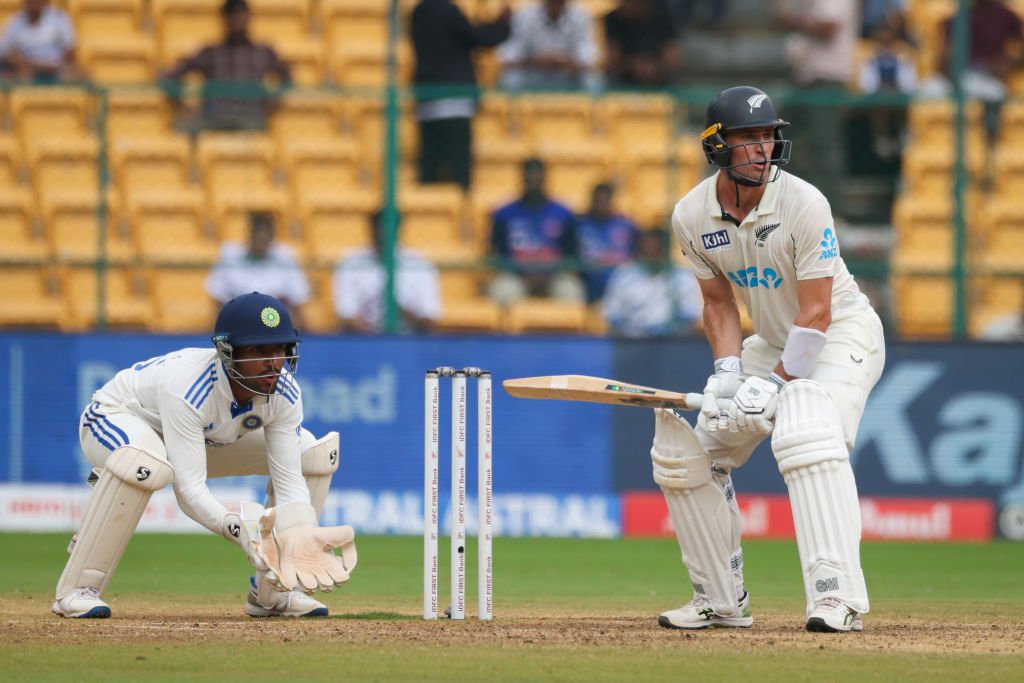
In an interesting shift from recent strategy, the Indian team is preparing to face New Zealand on a “sporting” pitch at Mumbai’s Wankhede Stadium for the third Test. After suffering consecutive losses on challenging surfaces in the first two Tests, India’s management has decided against rolling out a traditional “rank-turner” pitch. The shift is strategic, as the team aims to reclaim confidence in their batting lineup and preserve their standing in the World Test Championship.
With this series, New Zealand secured their first-ever Test series win on Indian soil, a historic achievement after taking decisive wins in both Bengaluru and Pune. The Pune pitch, a turn-friendly surface in the second Test, proved particularly troublesome for the Indian batsmen, with innings collapsing for 156 and 245, giving New Zealand a considerable advantage. These losses highlighted the inherent risks of rank-turners, which can destabilize not only visiting teams but also the hosts themselves, exposing weaknesses in batting consistency. New Zealand, armed with spin talent and a resilient lineup, exploited the conditions fully, putting India in a challenging spot ahead of the final Test.
This upcoming third Test presents a calculated shift in approach. The Wankhede pitch is expected to offer a balanced experience, allowing for both batting and bowling possibilities, which should make for a more even contest. This “sporting” track is likely to be more favorable to batting initially, allowing for high scores before gradually providing opportunities for spin as the game progresses. This track setup benefits India in multiple ways. Firstly, it allows top-order batsmen the chance to build momentum without immediate threats from extreme spin. Secondly, it mitigates the strength of New Zealand’s spin attack by delaying when the pitch will favor spinners, potentially leveling the playing field in India’s favor.
Historically, India has seen both wins and challenges on rank-turners. Such tracks, although beneficial to India’s celebrated spinners like Ravichandran Ashwin and Ravindra Jadeja, can also backfire by leveling skill gaps between India’s spinners and those of the opposition. For instance, earlier this year in Indore against Australia, India’s batters struggled, losing wickets for low scores. Although India managed a victory, the unpredictable nature of rank-turners means a single standout performance from a batsman can dictate the match’s outcome. For instance, England’s Ben Stokes and Ollie Pope have displayed aggressive, high-impact knocks on turning tracks, proving that skillful opposition players can thrive on these surfaces and swing the game in their team’s favor.
The decision to prepare a more balanced track at Wankhede is part of a broader strategic rethink for India. In the current series, where New Zealand’s spin and batting depth have both been pivotal, India needs a pitch that will bring their own top-order strengths into play, ideally reducing the early impact of spin and allowing skilled batters like Rohit Sharma and Virat Kohli time to settle and build significant scores. Moreover, this approach also favors India’s formidable spin-bowling duo, Ravichandran Ashwin and Ravindra Jadeja, in the later stages when the pitch starts to deteriorate naturally. This would ideally allow India to use spin as a weapon without relying solely on extreme pitch conditions to level the playing field.
Historically, India’s reliance on rank turners has had mixed results, with high-reward victories alongside unforeseen challenges when opposition batters rise to the occasion, such as England’s Ollie Pope and Ben Stokes, who have shown resilience and aggression on spin-friendly tracks. A sporting pitch at Wankhede is expected to make the game’s outcome less of a “lottery,” balancing between batting skill and spin challenges, and could allow both teams’ players to showcase their abilities more comprehensively. As the Test series culminates in Mumbai, all eyes will be on whether this shift in pitch preparation can help India end the series on a positive note and regain momentum in the World Test Championship.
The decision to create a balanced pitch at Wankhede also reflects lessons learned from recent losses on spin-friendly surfaces. As India grapples with adjusting their lineup, particularly after a series of injuries and batting challenges, the Wankhede track is anticipated to reduce these vulnerabilities and allow India’s star batters to focus on accumulating substantial runs. For fans and strategists alike, watching whether Rohit Sharma’s squad can capitalize on this home advantage will be crucial, especially since a win would not only be a morale boost but also keep them competitive in the World Test Championship standings.
In all, the Wankhede track promises an intriguing dynamic for the final Test. As the third and last game of the series, this Test is critical for both teams. For India, it’s a chance to rebound from a disheartening series and finish on a high note. For New Zealand, it’s an opportunity to assert their recent gains further and end the tour with an undefeated record. This contest will be one to watch as players adapt to a surface that demands versatility in strategy, potentially offering thrilling sessions of batting, pace, and spin. Whether the Indian team can turn their fortunes on this sporting track remains to be seen, but it’s clear that the stakes and anticipation are high for the series finale.

